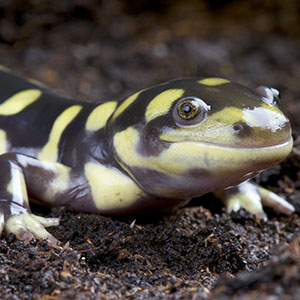
Salamanders are nocturnal creatures that create their habitat mainly in the Great Smoky Mountains of Tennessee. The moist moss and abundant greenery in the Great Smoky Mountains National Park make for a comfortable environment for these amphibians. Their porous skin requires constant moisture in order for them to thrive in the wild, and the Smokies offer just that. In the family of amphibians with newts, sirens, and amphiumas, salamanders have smooth, moist, porous skin, have long tails, and lay jelly-like eggs.
Because they can be found in both moist and terrestrial habitats, these salamanders are often used by scientists to test the environment. The unique heritage in the Smoky Mountains led the state legislature agreed that the Tennessee cave salamander should be the official state amphibian.
Most of the salamanders that are found in the Smoky Mountains have what is called a biphasic life cycle. This means they have spent part of their lifespan so far in a tadpole-like larval stage before morphing into the adult stage. Once in their adult life, many different species of salamanders spend much time on land in a moist environment. They will stay near water to keep their porous skin healthy. Although often confused with lizards, salamanders are not reptiles because they do not have scales on their skin. They also have claws on their toes, which reptiles do not.
As the world grows, the majority of people are expanding into new environments, causing amphibians to lose their habitats at a startling rate. The loss of these natural resources places a strain on amphibians. In order to court and breed, the salamanders need to lay their eggs in ponds that don’t have fish because fish eat amphibians. When the number of ponds are reduced, fewer salamanders survive.
You might notice various types of salamanders as you explore the national forest on your next vacation. Some to look out for include the Spotted Salamander, the Tiger Salamander, and the Santeetlah Dusky Salamander. The Spotted Salamander is found all over Tennessee. With similar coloring to the Easter Tiger Salamander, the major difference you will notice is the irregularity in the patterns as well as the coloring of the skin. This salamander uses its sticky tongue to catch its prey, which includes worms and other invertebrates that can be found on the forest floor. One thing to watch out for is that the Spotted Salamander has poison glands on their skin, back, and tail.
The Tiger Salamander is the largest terrestrial salamander in North America. With a large sturdy body, these salamanders are typically seven to eight inches in length. Because of deforestation, the population has declined in the Southeast. These animals usually breed in late winter or early spring. The females can produce anywhere from 100 to 1,000 in a season.
The Santeetlah Dusky Salamander can be found in higher elevations in East Tennessee. They feed on small invertebrate, and the name Santeetlah is thought to mean “blue water” in the Cherokee language. The habitat of these amphibians can be found along small streams that flow through areas of high elevation.
If you are interested in exploring the Great Smoky Mountains National Park next time you are in the area, be sure you have a relaxing cabin rental to return to at night. Cabins For You has plenty of rentals that offer easy access to the Great Smoky Mountains National Park. Give us a call to find out about availability and pricing today at 1-800-684-7865!
